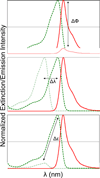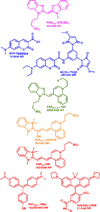Dark dyes-bright complexes: fluorogenic protein labeling
- PMID: 26056741
- PMCID: PMC4553107
- DOI: 10.1016/j.cbpa.2015.05.014
Dark dyes-bright complexes: fluorogenic protein labeling
Abstract
Complexes formed between organic dyes and genetically encoded proteins combine the advantages of stable and tunable fluorescent molecules and targetable, biologically integrated labels. To overcome the challenges imposed by labeling with bright fluorescent dyes, a number of approaches now exploit chemical or environmental changes to control the properties of a bound dye, converting dyes from a weakly fluorescent state to a bright, easily detectable complex. Optimized, such approaches avoid the need for removal of unbound dyes, facilitate rapid and simple assays in cultured cells and enable hybrid labeling to function more robustly in living model organisms.
Copyright © 2015 Elsevier Ltd. All rights reserved.
Figures




References
-
- Westphal V, Rizzoli SO, Lauterbach MA, Kamin D, Jahn R, Hell SW, et al. Video-rate far-field optical nanoscopy dissects synaptic vesicle movement. Science. 2008;320(5873):246–249. - PubMed
-
- Lukinavicius G, Reymond L, D'Este E, Masharina A, Gottfert F, Ta H, Guther A, Fournier M, Rizzo S, Waldmann H, Blaukopf C, et al. Fluorogenic probes for live-cell imaging of the cytoskeleton. Nature methods. 2014;11(7):731–733. - PubMed
-
- Gustafsson MG, et al. Surpassing the lateral resolution limit by a factor of two using structured illumination microscopy. Journal of microscopy. 2000;198(Pt 2):82–87. - PubMed
-
- Betzig E, Patterson GH, Sougrat R, Lindwasser OW, Olenych S, Bonifacino JS, Davidson MW, Lippincott-Schwartz J, Hess HF, et al. Imaging intracellular fluorescent proteins at nanometer resolution. Science. 2006;313(5793):1642–1645. - PubMed
Publication types
MeSH terms
Substances
Grants and funding
LinkOut - more resources
Full Text Sources
Other Literature Sources

